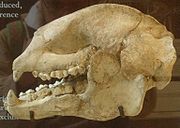
Ailuropoda
Encyclopedia

Genus
In biology, a genus is a low-level taxonomic rank used in the biological classification of living and fossil organisms, which is an example of definition by genus and differentia...
in the ursid
Bear
Bears are mammals of the family Ursidae. Bears are classified as caniforms, or doglike carnivorans, with the pinnipeds being their closest living relatives. Although there are only eight living species of bear, they are widespread, appearing in a wide variety of habitats throughout the Northern...
(bear) subfamily Ailuropodinae. It contains one living and four fossil species of giant panda
Giant Panda
The giant panda, or panda is a bear native to central-western and south western China. It is easily recognized by its large, distinctive black patches around the eyes, over the ears, and across its round body. Though it belongs to the order Carnivora, the panda's diet is 99% bamboo...
.
Only one species — Ailuropoda melanoleuca — currently exists; the other four species are prehistoric chronospecies
Chronospecies
A chronospecies describes a group of one or more species derived from a sequential development pattern which involves continual and uniform changes from an extinct ancestral form on an evolutionary scale. This sequence of alterations eventually produces a population which is physically,...
. Despite its taxonomic
Alpha taxonomy
Alpha taxonomy is the discipline concerned with finding, describing and naming species of living or fossil organisms. This field is supported by institutions holding collections of these organisms, with relevant data, carefully curated: such institutes include natural history museums, herbaria and...
classification as a carnivoran
Carnivora
The diverse order Carnivora |Latin]] carō "flesh", + vorāre "to devour") includes over 260 species of placental mammals. Its members are formally referred to as carnivorans, while the word "carnivore" can refer to any meat-eating animal...
, the giant panda has a diet
Diet (nutrition)
In nutrition, diet is the sum of food consumed by a person or other organism. Dietary habits are the habitual decisions an individual or culture makes when choosing what foods to eat. With the word diet, it is often implied the use of specific intake of nutrition for health or weight-management...
that is primarily herbivorous, which consists almost exclusively of bamboo
Bamboo
Bamboo is a group of perennial evergreens in the true grass family Poaceae, subfamily Bambusoideae, tribe Bambuseae. Giant bamboos are the largest members of the grass family....
.
Giant pandas are descended from Ailurarctos
Ailurarctos
Ailurarctos is an extinct genus of panda from the Late Miocene of China, some 8 million years ago.-References:* http://www.kepu.net.cn/english/giantpanda/giantpanda_evolution/200409230025.html...
, which lived during the late Miocene
Miocene
The Miocene is a geological epoch of the Neogene Period and extends from about . The Miocene was named by Sir Charles Lyell. Its name comes from the Greek words and and means "less recent" because it has 18% fewer modern sea invertebrates than the Pliocene. The Miocene follows the Oligocene...
.
Classification
- †Ailuropoda microtaAiluropoda microtaAiluropoda microta, rarely called the Dwarf Panda, Dwarf Giant Panda, or Pygmy Giant Panda, is the earliest known ancestor of the Giant Panda. It measured 1 m in length; the modern Giant Panda grows to a size in excess of 1.5 m . Wear patterns on its teeth suggest it lived on a diet of...
Pei, 1962 (late PliocenePlioceneThe Pliocene Epoch is the period in the geologic timescale that extends from 5.332 million to 2.588 million years before present. It is the second and youngest epoch of the Neogene Period in the Cenozoic Era. The Pliocene follows the Miocene Epoch and is followed by the Pleistocene Epoch...
) - †Ailuropoda wulingshanensis Wang et alii. 1982 (late Pliocene - early PleistocenePleistoceneThe Pleistocene is the epoch from 2,588,000 to 11,700 years BP that spans the world's recent period of repeated glaciations. The name pleistocene is derived from the Greek and ....
) - †Ailuropoda baconi (Woodward 1915) (Pleistocene)
- †Ailuropoda minor Pei, 1962 (Pleistocene)
- Ailuropoda melanoleucaGiant PandaThe giant panda, or panda is a bear native to central-western and south western China. It is easily recognized by its large, distinctive black patches around the eyes, over the ears, and across its round body. Though it belongs to the order Carnivora, the panda's diet is 99% bamboo...
(David, 1869)- Ailuropoda melanoleuca melanoleuca (David, 1869)
- Ailuropoda melanoleuca qinlingensisQinling PandaThe Qinling panda is a subspecies of the giant panda, discovered in the 1960s but not recognized as a subspecies until 2005. Disregarding the nominate subspecies, it is the first giant panda subspecies to be recognized...
Wan Q.H., Wu H. et Fang S.G., 2005 - †Ailuropoda melanoleuca hastorni
Other pandas
Formerly, the red, or lesser, pandaRed Panda
The red panda , is a small arboreal mammal native to the eastern Himalayas and southwestern China. It is the only species of the genus Ailurus. Slightly larger than a domestic cat, it has reddish-brown fur, a long, shaggy tail, and a waddling gait due to its shorter front legs...
(Ailurus fulgens) was considered closely related to giant pandas. It is not considered a bear, however, and is now classified as the sole living representative of a different carnivore family (Ailuridae
Ailuridae
Ailuridae is a family in the mammal order Carnivora. The family includes the Red Panda and its extinct relatives.-Classification history:...
).

